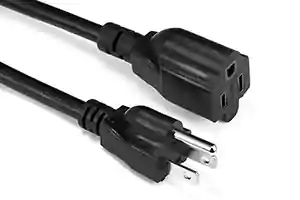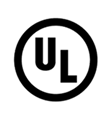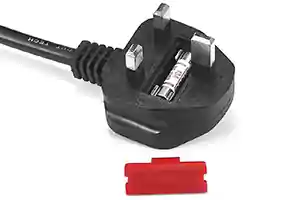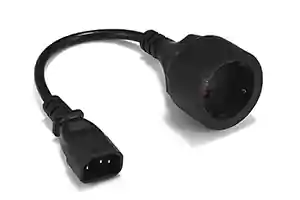TThe electricity Type E plug is identified by two round pins spaced 19mm apart, with a hole for the socket’s male grounding pin. Type E outlets will also accept Type C plugs, and Type E plugs will also work in Type F outlets.
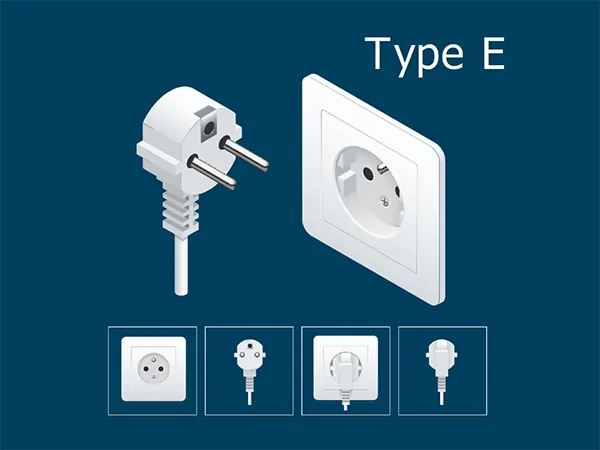
Table of Contents
What is a Type E plug?
The Type E plug has two round pins (diameter 4.8mm, centers spaced 19mm apart) and a hole for the earth pin. The Type E plug is round, and the Type E socket has a round recess.
Note: The CEE 7/7 plug can be used with Type E and Type F sockets. It has a hole (for the earth pin of Type E sockets) and earth clips on the sides (to work with Type F sockets).
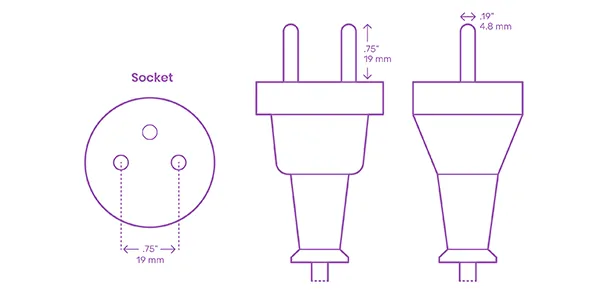
Type E plug features
France, Belgium, and some other countries have standardized a socket that is different from the CEE 7/4 socket (type F) standard in Germany and other continental European countries. Fortunately, type F plugs are compatible with type E sockets and the other way round. In the past, however, this wasn’t the case. The initial incompatibility was that grounding in the E socket is accomplished with a round male pin, which is permanently mounted in the socket.
Old type F plugs did not have a grounding hole to accept the earth pin of the type E socket. This grounding pin is 14 mm long and has a diameter of 4.8 mm. The plug itself is similar to C except that it is round and has a female contact to accept the socket’s grounding pin. The plug has two 4.8 mm round pins, measuring 19 mm in length on centers spaced 19 mm apart. The center-to-center distance between the female contact and the middle of the imaginary line connecting the two power pins is 10 mm.
The now universal Continental European standard E/F plug was developed to bridge the differences between sockets E and F, officially called CEE 7/7. It has top and bottom indentations with earthing clips to mate with the type F socket, and it has a female contact to accept the grounding pin of the type E socket. The hybrid E/F plug is not perfectly round but has a pair of plastic notches on the left and right sides to fit the type F socket.
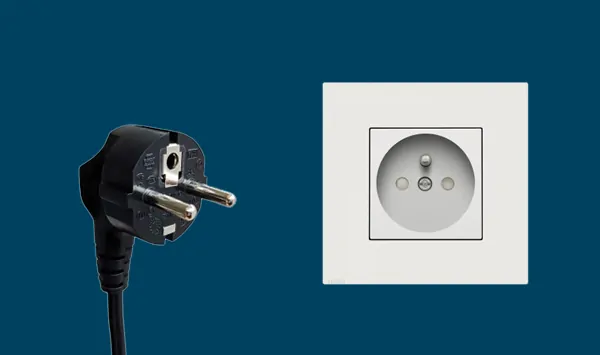
The original type E plug, which is round and does not have grounding clips, is no longer used. However, very rarely, it can still be found on some older appliances. Note that the CEE 7/7 plug is polarised when used with a type E outlet. The plug is rated at 16 amps. Above that, equipment must either be wired permanently to the mains or connected via another higher power connector such as the IEC 60309 system. A type C plug fits perfectly into a type E socket. The socket is recessed by 15 mm, so partially inserted plugs do not present a shock hazard.
Are Type C and E plugs interchangeable?
The electricity Type C plug (or Europlug) is a two-wire plug with two round pins. It fits into any socket that accepts 4.0 – 4.8 mm round contacts on 19 mm centers. They are being replaced by E, F, J, K, or N sockets which work perfectly with Type C plugs.
The electricity Type E plug has two 4.8 mm round pins spaced 19 mm apart and a hole for the socket’s male earthing pin. The Type E plug has a rounded shape, and the Type E socket has a round recess. Type E plugs are rated 16 amps.
The Type F electrical plug (also known as a Schuko plug) has two 4.8 mm round pins 19 mm apart. It is similar to the Type E plug but has two earth clips on the side rather than a female earth contact. The CEE 7/7 plug was developed to work with sockets E and F and has grounding clips on both sides (to work with Type F sockets) and a female contact (to accept the grounding pin of the type E socket).
Where is the Type E plug used?
Used in countries:
| Belgium | 230V 50Hz | Power socket: Type C, Type E |
| Benin | 220V 50Hz | Power socket: Type C, Type E |
| Burkina Faso | 220V 50Hz | Power socket: Type C, Type E |
| Burundi | 220V 50Hz | Power socket: Type C, Type E |
| Cameroon | 220V 50Hz | Power socket: Type C, Type E |
| Central African Republic | 220V 50Hz | Power socket: Type C, Type E |
| Chad | 220V 50Hz | Power socket: Type C,Type D, Type E, Type F |
| Comoros | 220V 50Hz | Power socket: Type C, Type E |
| Congo | 230V 50Hz | Power socket: Type C, Type E |
| Cote d'Ivoire | 230V 50Hz | Power socket: Type C, Type E |
| Czech Republic | 230V 50Hz | Power socket: Type C, Type E |
| Denmark | 230V 50Hz | Power socket: Type C, Type F, Type E, Type K |
| Djibouti | 220V 50Hz | Power socket: Type C, Type E |
| Equatorial Guinea | 220V 50Hz | Power socket: Type C, Type E |
| Ethiopia | 220V 50Hz | Power socket: Type C, Type E, Type F, Type L |
| Faroe Islands | 230V 50Hz | Power socket: Type C, Type F, Type E, Type K |
| France | 230V 50Hz | Power socket: Type C, Type E |
| French Guiana | 220V 50Hz | Power socket: Type C, Type D, Type E |
| Greenland | 230V 50Hz | Power socket: Type C, Type F, Type E, Type K |
| Guadeloupe | 230V 50Hz | Power socket: Type C,Type D, Type E |
| Lao People's Democratic Republic | 230V 50Hz | Power socket: Type A, Type B, Type C, Type E, Type F |
| Liberia | 120V 220V 50Hz, 60Hz | Power socket: Type A, Type B, Type C, Type E, Type F |
| Madagascar | 127V 220V 50Hz | Power socket: Type C, Type D, Type E, J, Type K |
| Mali | 220V 50Hz | Power socket: Type C, Type E |
| Martinique | 220V 50Hz | Power socket: Type C,Type D, Type E |
| Monaco | 230V 50Hz | Power socket: Type C,Type D, Type E, Type F |
| Mongolia | 220V 50Hz | Power socket: Type C, Type E |
| Morocco | 127V 220V 50Hz | Power socket: Type C, Type E |
| Niger | 220V 50Hz | Power socket: Type A, Type B, Type C, Type D, Type E, Type F |
| Poland | 230V 50Hz | Power socket: Type C, Type E |
| Reunion | 220V 50Hz | Power socket: Type E |
| SaintVincent and the Grenadines | 230V 50Hz | Power socket: Type A, Type C, Type E, Type G, Type I, Type K |
| Senegal | 230V 50Hz | Power socket: Type C, D, Type E, Type K |
| Slovakia | 230V 50Hz | Power socket: Type C, Type E |
| Syrian Arab Republic | 220V 50Hz | Power socket: Type C, Type E, Type L |
| Timor-Leste | 220V 50Hz | Power socket: Type C, Type E, Type F, Type I |
| Tunisia | 230V 50Hz | Power socket: Type C, Type E |
Type E plug certificate
LCIE agency approvals and certifications are available on the product specification page, IEC Type E Plug.
We have made a very detailed graphic introduction in the article safety marks for more information about the safety certification of power cord plugs.
Now It’s Your Turn
So that’s how I understand Type E plug and socket.
Now I want to turn it over to you: Through my article, do you understand Type E Plugs and Sockets (Outlets)?
Do you have a different point of view with the power plug type E? Or any other questions?
Let me know by leaving a quick comment below right now.
